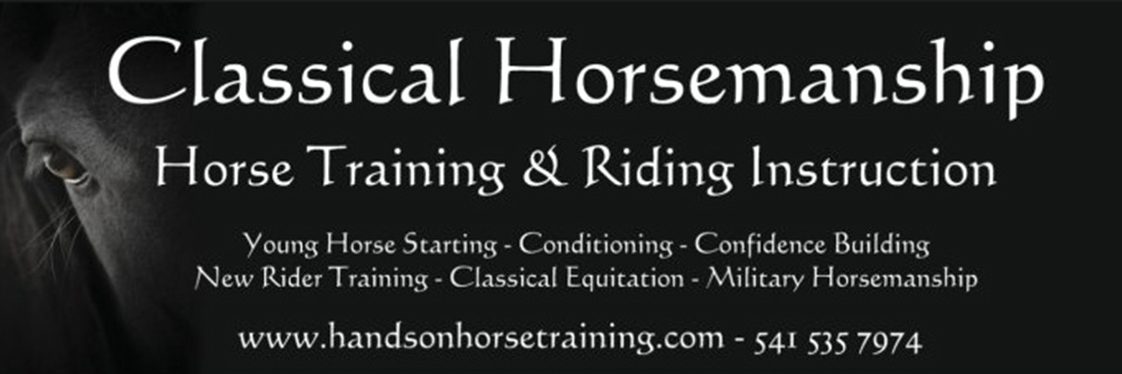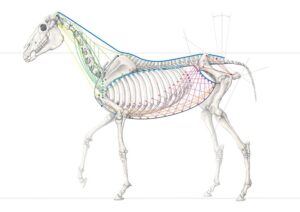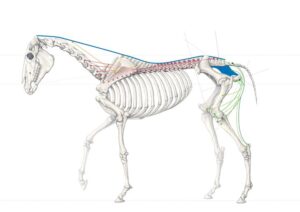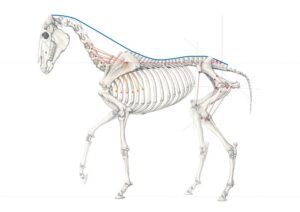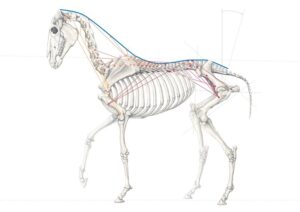I ran across these on Christine Sander’s Facebook page and some of the comments below were offered by her. They are intended to show the muscle groups that are in use when a horse is at various levels of collection.
The information processed in these illustrations is from Goody “Horse Anatomy”. What he provides on page 20 are two diagrams of the horse’s major muscle systems, which are the basis for these four illustrations. Provided are muscle insertions, which are connected by vector lines. This permits the viewer to understand the direction and coordination of muscles, which because of muscle layering often remain obscure. They have done a good job of associate the muscle systems Goody shows in these diagrams with the horse’s posture. It was no surprise to come up with a classical ideal. I.e. in my view, the classical ideal is the direct result of how in fact the horse is. The different colors merely represent different muscle groups and the direction of force.
The point here is not to illustrate gates, but muscle systems and how they relate to the horse’s posture. I.e., the mounted horse begins to train in the traveling position (1), always ought to have the option of a stretched position (2), and begins to elevate in the working position (3) working toward the finished position (4).
Standard Carriage: This illustration represents the first phase of training. Head up and fore, croup closed, a time to get to know the rider and strengthen the muscles of the croup. Not everyone will agree with the suggestion that the closing of the croup is affected by the diagonal abdominal muscle, as shown, but my experience supports this.
Long and Low: Here the horse extends and lowers its head and neck. This moves more weight to the forehand, but at the same time stretches the back muscles. Different trainers hold different opinions about this, but I see it as a good way to relax the horse and prepare the back for more collection work.
One thing needs to be mentioned. The change in neck placement is the result of changes in the musculature of the back. The horse should not be induced to lower the neck, as this introduces a wrong goal.
This plays into the horse’s dual nature. For feeding it lowers the neck. In locomotion, it raises the neck. A horse is evolved to lower its head when at ease and raise it when athletic movement is required.
This is an excellent reward carriage. When I am working horses I return to walking on the loose rein from time to time and allow the horse to take this carriage and just walk quietly. By quietly I do not mean dragging its feet along. The horse should still be asked to move at a proper walking pace, but be allowed to take the “Long and Low” and stretch its back. After a bit of this, the horse should begin to “blow” out or even start yawning as a sign of relaxation.
I often end a training session by riding with no reins at all, doing all the steering with legs and seat alone. This position is nearly always the one the horse adopts.
Working Position: This one shows the horse in what a lot of folks would call proper collection.
Compared to the earlier images you can clearly see the weight shift from fore to hind and the center of gravity moved back. However, even though there is a good bend at the poll, the head and neck are still slightly forward from the “classical” ideal.
In this posture, the horse takes control of this “other mode”. It is the only mode that permits the horse’s self-control and transfers to the rider. Shown are the muscle systems that permit the rising of the withers and the flexibility of the haunches. They are the basis of the horse’s dynamic balance.
A horse that readily adopts this position with a rider on its back will be better able to carry itself in a balanced way. It will be able to perform better, more collected turns and generally be a better ride.
This Working Position is as collected as some horses are capable of due to conformation imperfections or even injury.
No horse, regardless of how perfect the conformation, can be expected to adopt this position while under saddle until conditioning allows. It takes time and patience, a light hand, and an independent seat to help the horse find this frame.
Under no circumstances should you try to “frame” the horse into this position by forcing its head and neck into place and then driving the hind end. The horse has to seek light contact on the bit and find its own frame.
Final Position: This is more the “Classical Ideal” of collection. The horse’s hind end is again, well under and carrying more of the weight, but the neck is more vertical. Look at the muscles use and how the center of gravity is moved to essentially directly under the rider.
Shown here are only the muscle systems that directly relate to the horse’s performance. Interesting is how they balance from head to hind legs.
VERY IMPORTANT, the headset does not create collection, collection creates the headset. Just forcing the horse’s head into this position is not collection. This is a very common misconception.
The horse must have the freedom to move for this frame to work. The horse will not have this freedom if one employs the “Grab and Jab” methods some modern riders employ. That is, forcing the head into the vertical position or too often past the vertical, then driving the horse forward with the spurs. When assaulted but such methods, some horses fight back fiercely, others give all they can to comply, but ALL of them do so in a tense stiff manner. How can anyone expect relaxation and flowing movement from this method?
It can take a very long time for the horse and the rider to come to this place, but the work is well rewarded with maximum agility and balance and minimum contact and input from the aids. Again, an independent seat and light, elastic contact on the bit is required.
Not all horses are built in such a way as to make this level of collection possible, but for those it is, the place this takes the horse/rider team is almost too wonderful to be believed.
